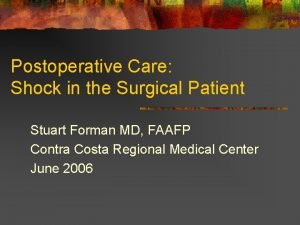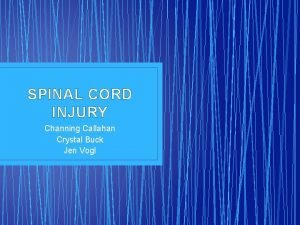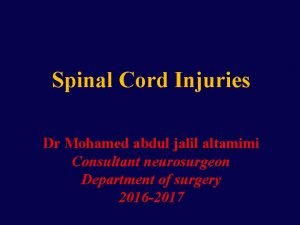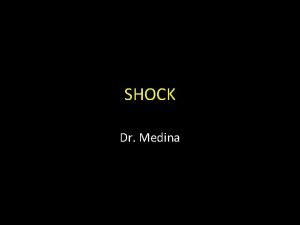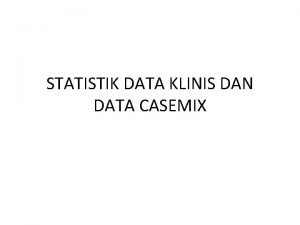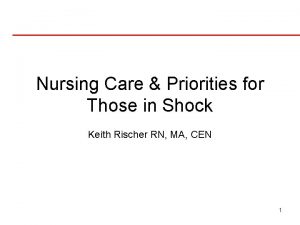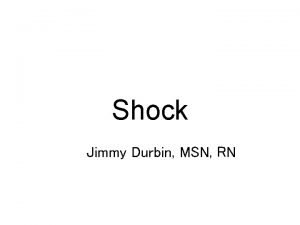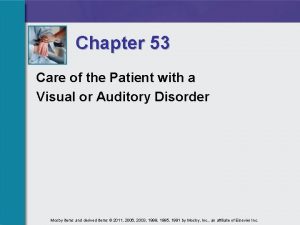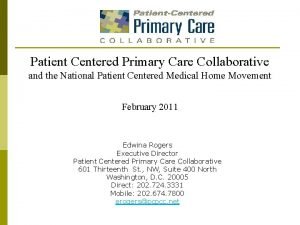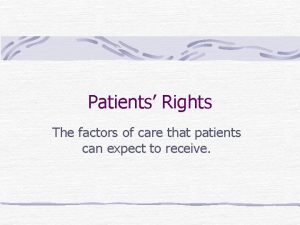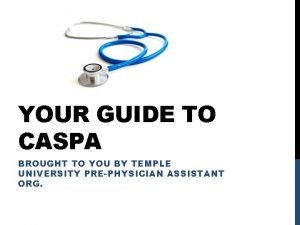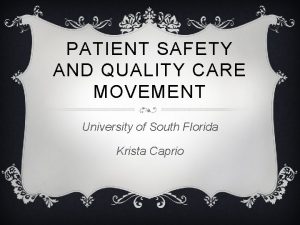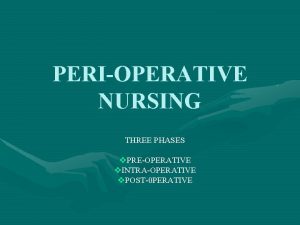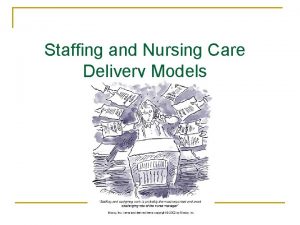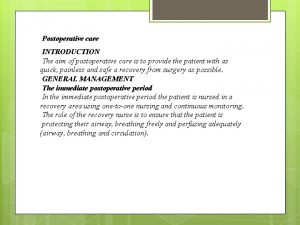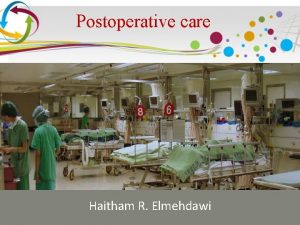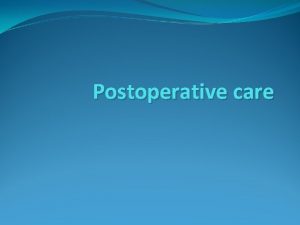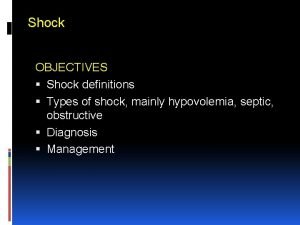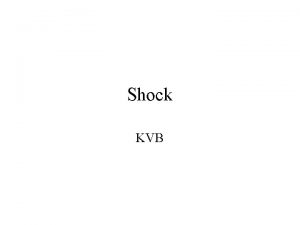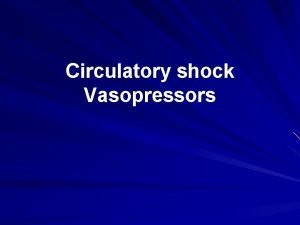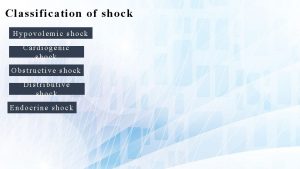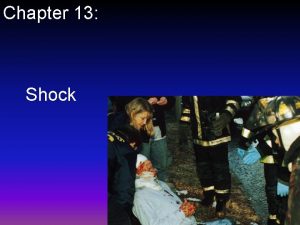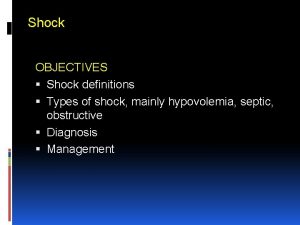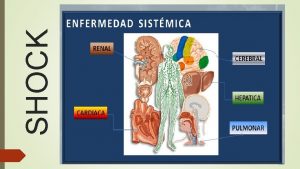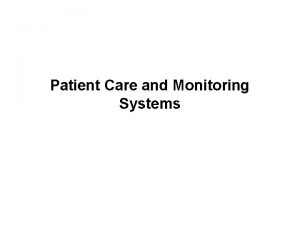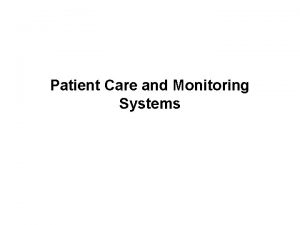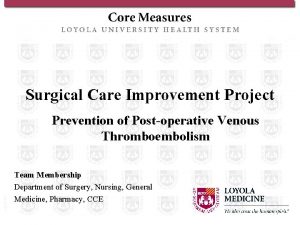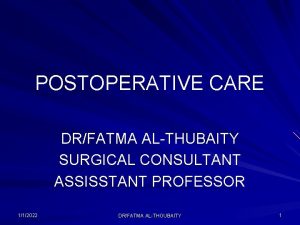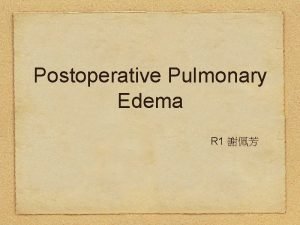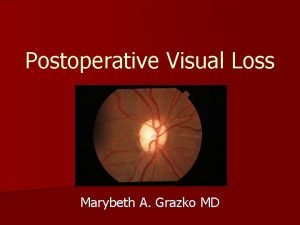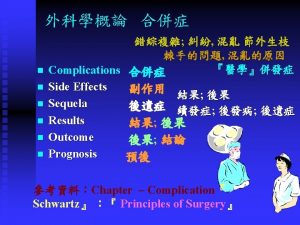Postoperative Care Shock in the Surgical Patient Stuart






















- Slides: 22

Postoperative Care: Shock in the Surgical Patient Stuart Forman MD, FAAFP Contra Costa Regional Medical Center June 2006

Fluids Good Lasix Bad

Thank you very much.

Basic Hemodynamics CO = HR X SV

Basic Hemodynamics CO = HR X SV “Volume”

Basic Hemodynamics CO = HR X SV LVEDP LAP “Volume” RAP RVEDP CVP PAP PCP

Basic Hemodynamics CO = HR X SV LVEDP LAP “Volume” RAP RVEDP CVP PVP “Contractility” PAP PCP

Basic Hemodynamics CO = HR X SV DO 2 = (CO)(Hgb)(Sa. O 2)c

Shock Recognition THINK about it!!

Early Recognition of Shock n THINK about everything that can go wrong n n n n Post operative hemorrhage Post operative sepsis Perforated intestine Post operative hypovolemia Post op MI etc. You can’t find it if you don’t THINK about it!

Easy Signs to Find n Urine output n n n The best CVP is if you see pee Think Foley Blood pressure Skin temperature Mental status Drain saturation

Laboratory Examination n CBC n n n Serial CBC for any patient with bleeding risk Lactate BUN / Cr Coagulation profile Electrolytes (specifically bicarb)

Resuscitation Fluids Crystalloid 0% 100% Intracellular Extracellular 2/3 Extravascular 1/3 Intravascular

Resuscitation Fluids Crystalloid 0% Colloid 100% Intracellular Extracellular 2/3 Extravascular 100% 1/3 Intravascular

Resuscitation Fluids n n No evidence to show that one type of fluid is superior to another in resuscitation Ensure that you use enough crystalloid.

Post operative Shock General Principles n n n Resuscitation with appropriate and enough fluids Give blood if bleeding or evidence of oxygen delivery problem Pressors to mitigate hypotension Stress dose steroids if indicated Intensive insulin Normothermia

Hypovolemic Shock—Bleeding n n Think about the surgery and everything that could go wrong Surgical bleeding vs. postoperative “oozing” Support with fluids and blood products. Treat hypothermia

Hypovolemic Shock—Inadequate Resuscitation n Patients are NPO for several hours prior to surgery Patients with intraabdominal processes (especially infection and SBO) have tremendous fluid losses. The best prevention of postoperative resuscitation problems is preoperative resuscitation.

Post-op Septic Shock n n Think about it! Utilize Rivers goal directed protocols n n n CVP 8 -12 Urine output > 0. 5 cc/kg/hr Sv. O 2 > 70 n n Hgb to 10, Dobutamine MAP>65 n Norepinephrine or Dopamine

Post-op Cardiogenic Shock n n Think about it. Patient may not complain of chest pain although there may be clues on exam. EKG/Echo/Swan/enzymes, etc. Must weigh risk of bleeding (ASA, thrombolytics, cath) vs. benefit n n Usually benefit of treating heart outweighs risk Inotropic support

Abdominal Compartment Syndrome n n n Post op laparotomy patients can be at risk for this as well as cirrhotics EASY to measure. Basically stick a foley catheter to a CVP monitor Abnormal is over 20 cm water. Dangerous over 30. Treatment is decompression You only find it if you THINK about it.

So… n n n n Resuscitation, resuscitation. Think about hypovolemia Think about bleeding. Think about sepsis. Think about abdominal compartment syndrome Get an EKG in high risk patients. And remember… The best treatment is PREVENTION
 Postoperative shock
Postoperative shock Care of critically ill surgical patient
Care of critically ill surgical patient Nursing diagnosis cataract nursing care plan
Nursing diagnosis cataract nursing care plan Preoperative nursing definition
Preoperative nursing definition Spinal shock vs neurogenic shock
Spinal shock vs neurogenic shock Spinal shock symptoms
Spinal shock symptoms Site:slidetodoc.com
Site:slidetodoc.com Spinal shock vs neurogenic shock
Spinal shock vs neurogenic shock Shock normovolemico
Shock normovolemico Data klinis
Data klinis Levels of care primary secondary tertiary quaternary
Levels of care primary secondary tertiary quaternary Patient 2 patient
Patient 2 patient Shock nursing care
Shock nursing care Nursing care plan for shock ppt
Nursing care plan for shock ppt Chapter 53 care of the patient with a sensory disorder
Chapter 53 care of the patient with a sensory disorder Patient centered primary care collaborative
Patient centered primary care collaborative Factors of care patients can expect to receive
Factors of care patients can expect to receive Caspa achievements examples
Caspa achievements examples Patient safety and quality care movement
Patient safety and quality care movement Perioperative care phases
Perioperative care phases Primary nursing model advantages and disadvantages
Primary nursing model advantages and disadvantages Site:slidetodoc.com
Site:slidetodoc.com Jcpp pharmacy
Jcpp pharmacy
